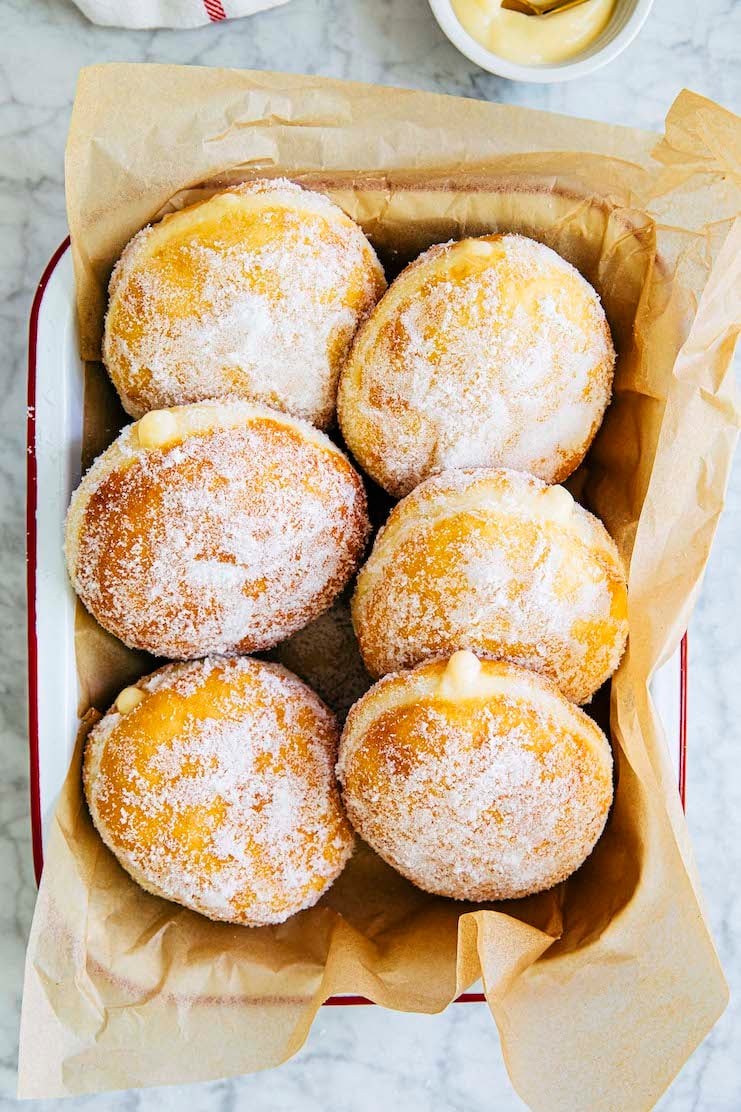
About These Malasadas
These homemade Hawaiian donuts are easy to make, thanks to a dough that comes together in just 15 minutes and is proofed overnight! The dough is then shaped into donuts, deep-fried, and filled with a tangy passion fruit-flavored pastry cream.
They are SO incredibly tasty and currently one of my favorite donut recipes on Hummingbird High!
@hummingbirdhigh this sound is my everyday manifestation #donuts #baking #malasadas #bakingrecipe ♬ original sound – masood_boomgaard
I adapted the recipe from my friend, Alana Kysar. She is a food blogger and cookbook author known for her Hawaiian recipes. In her book, she writes that her recipe was inspired by Leonard’s Bakery, a Honolulu bakery famous for its malasadas!
Looking for more Hawaiian dessert recipes? Check out this Guava Chiffon Cake with Guava Cream Cheese Frosting and these Small Batch Baked Ube Mochi Donuts.
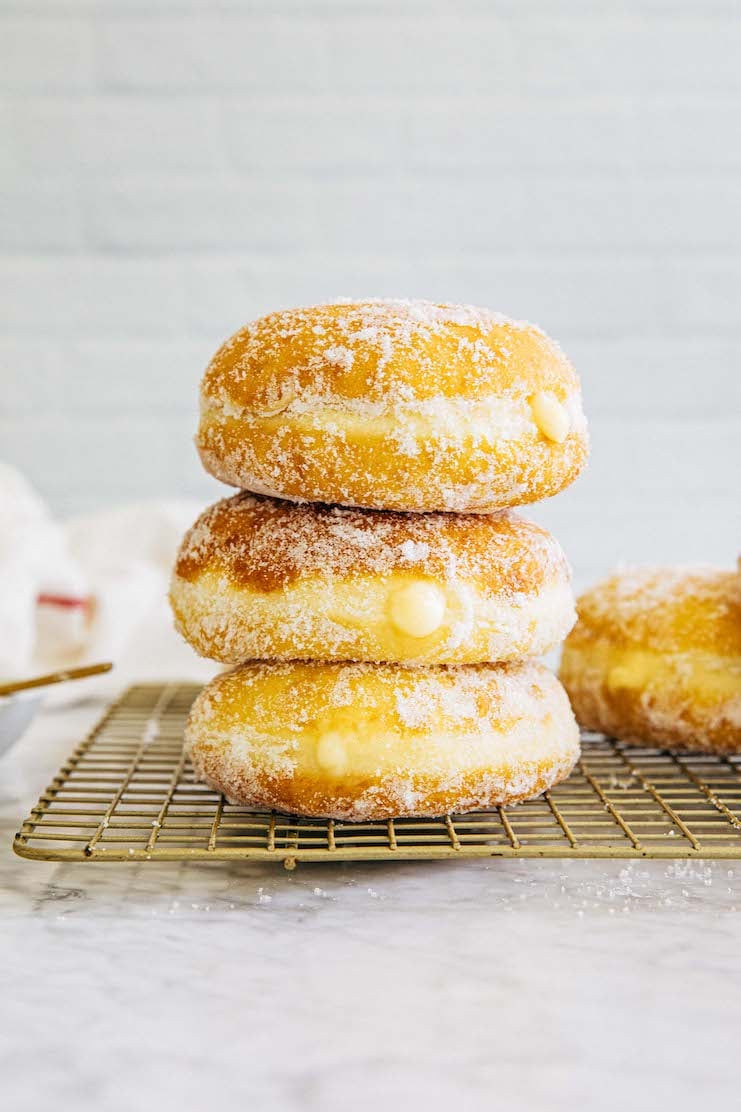
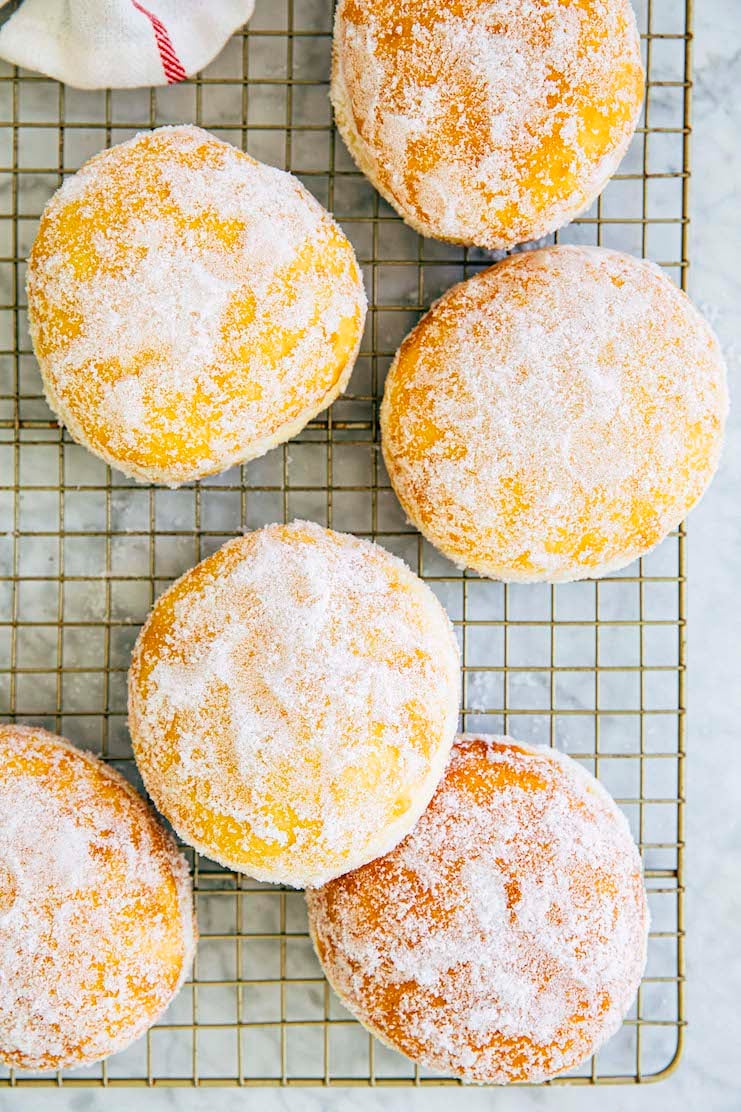
What You Need
Sources, Recommendations, and Substitutions
- Bread Flour. Bread flour contains more protein (between 14% and 16%) than all-purpose flour (which only contains between 10% and 12%). This higher protein contents helps develop gluten and structure, which is perfect for creating crusty breads and chewy baked goods. In this particular recipe, the bread flour makes the Hawaiian donuts chewier!
- Instant Yeast. In a pinch, you can use active dry yeast instead of instant yeast. Follow the packet instructions to activate it with some of the milk in the recipe!
- Kosher Salt. Kosher salt is the best salt for baking recipes. But if you don’t have any on hand, you can use table salt. Just use half the amount listed in this recipe!
- Whole Milk. Use whole milk to make the best tasting malasadas (though in a pinch, you can use skim or low fat milk). You can also use plant-based milks like almond, coconut, oat, or soy. Just note that the donuts might end up tasting like whatever milk you choose.
- Passion Fruit Puree. You can “make” your own passion fruit puree by scooping out the insides of a passion fruit. But you can also buy passion fruit puree online, in Hispanic grocery stores, or in fancy gourmet shops. The fancy pastry school kind by Monin is usually pretty expensive. I recommend going to a Hispanic grocery store and finding a pouch of Goya passion fruit pulp—these typically only cost between $2 and $3!
Can I use all-purpose flour instead of bread flour to make these malasadas?
Yes! In a pinch, you can use the same amount of all-purpose flour (which is 2 cups/9 ounces/255 grams) to make these malasadas. However, your donuts probably won’t be as chewy as mine. They’ll still be tasty though!
Can I use passion fruit juice instead of passion fruit puree?
Yes, but with caution. Passion fruit juice typically has added preservatives and sugars in it. If you use it in this recipe, your pastry cream will likely turn out too sweet!
And ven if you find a juice that doesn’t have any preservatives or sugars, there’s a good chance that it is watered down. The passion fruit pastry cream might NOT set properly if you use passion fruit juice!
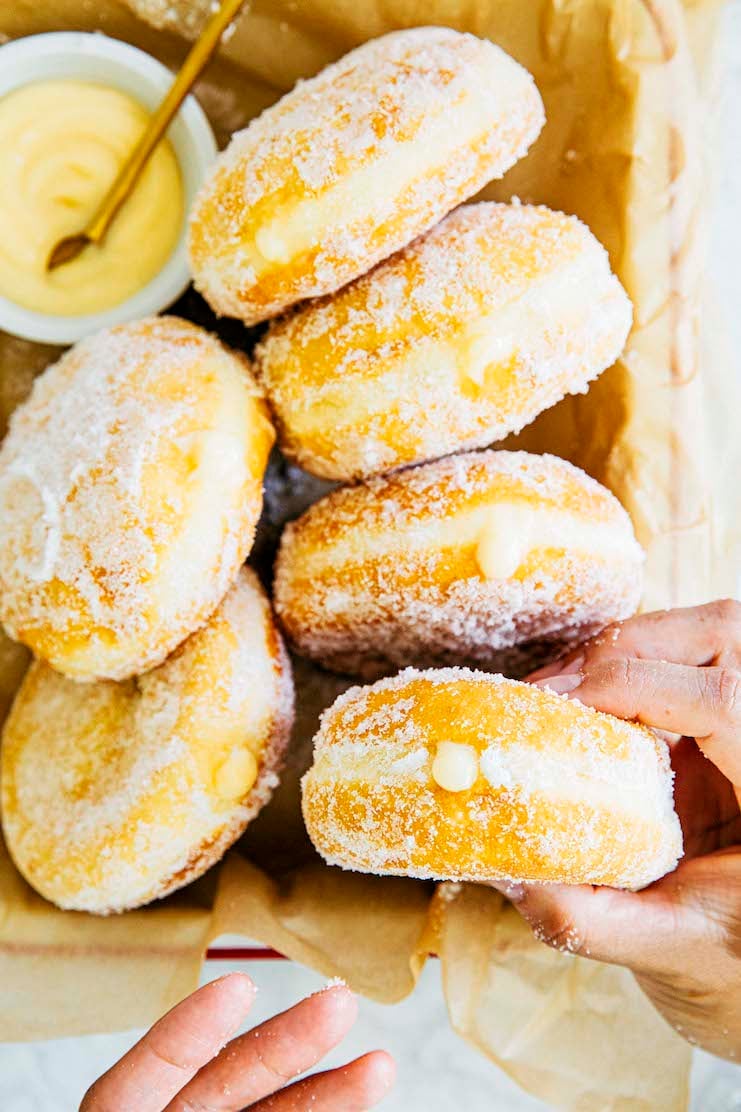

Recipe Troubleshooting and FAQ
I don’t have a stand mixer. Can I still make the recipe?
Absolutely! Instead of using a stand mixer, knead the dough by hand until it is smooth and elastic. The recipe instructs you to knead it for 10 minutes in a stand mixer; however, you may need to do a few minutes of extra kneading when doing it by hand.
I don’t have a deep-fryer. Can I still make malasadas?
Absolutely! I don’t own a deep-fryer myself. Instead, I used a heavy-bottomed pot with tall sides (specifically, this Dutch oven). I affixed a deep-fry thermometer to its side to monitor the oil’s temperature and called it a day!w
Note that the Dutch oven I linked to has a capacity of 7 quarts; however, I’ve also made these malasadas in a 5-quart Dutch oven.
Do I really need a Bismark pastry tip to make malasadas?
No! A Bismark pastry tip is great for filling donuts because its long nozzle enables you to fill the entirety of the donut. A regular pastry tip won’t be able to achieve the same depth.
But if a regular pastry tip is all you have, no worries! Use a skewer or a chopstick to poke a deep hole in each donut. Then, use a regular pastry tip to fill the hole.
Can I double the recipe to make a full batch of malasadas?
Yes! Doing so will make 12 malasadas. No need to change anything else about the recipe—all instructions will stay the same!
Help! My malasadas didn’t rise and/or don’t look as tall and fluffy as yours. They are much smaller and denser. What did I do wrong?
First things first: did you pay attention to the temperature of the ingredients listed in the recipe? I mentioned earlier that, for these Hawaiian donuts, it’s super important to prep your ingredients to the temperature listed in the recipe. If the water or butter is too hot, it will kill the yeast—your rolls won’t rise and/or be as tall and fluffy as mine. If the milk and eggs are too cold, it won’t activate the yeast—your buns won’t rise and/or be as tall and fluffy as mine, either.
Second: did you proof the dough right? Typically, donut dough needs to be proofed twice. The second rise allows the malasadas to develop an airy crumb, with a light and chewy texture that is the hallmark for good bread. If you don’t proof the malasadas properly, especially during the second rise, they’ll come out small and dense.
So how do you tell if you’ve proofed the dough right? Press the top of a roll gently with your finger. If the dough springs back right away, it needs to be proofed more. But if it springs back slowly and leaves a small indent, it’s ready to bake!
Best Recipe Tips
- For this recipe, it’s important that all its ingredients are at the temperature listed in the recipe. Why? First of all, remember that yeast is a living thing. If you activate the yeast at a temperature that’s too warm, you might accidentally kill the yeast and end up with a dough that doesn’t rise.
However, on the flip side, the yeast won’t activate if other ingredients—like the milk, eggs, and butter—are too cold. So, to really set yourself up for success, take the extra 5 minutes to make sure all the ingredients are measured out and are at the right temperatures! - You need to proof the malasadas for a second time after you’ve shaped them. During this rise time, I prep my fry station and preheat the fry oil. It takes a surprisingly long amount of time to preheat the oil to the right temperature!
- Depending on the size of my pot or deep-fryer, I typically only fry 2 to 3 malasadas at a time. Why? Overcrowding the pot tends to cause a dramatic drop in the frying oil’s temperature. So I like to be on the safe side and fry in small batches.
If you fry 2 malasadas at a time, you’ll do 3 batches total and have a total Cook Time will be 12 minutes. If you fry 3 malasadas at a time, you’ll do 2 batches total and have a total Cook Time of 8 minutes.
Get the Recipe: Malasadas (Hawaiian Donuts) Recipe
Ingredients
For the Malasada Dough
- 2 cups (9 ounces or 255 grams) bread flour, plus more for assembly
- 1 teaspoon granulated sugar
- 1 (0.25-ounce) packet instant yeast
- ½ teaspoon kosher salt
- ¾ cup (6 ounces or 170 grams) whole milk, warmed to between 120° to 130°F
- 1 large egg, at room temperature
- 1 large egg yolk, at room temperature
- 2 Tablespoons (1 ounce or 28 grams) unsalted butter, melted and cooled slightly
For the Passion Fruit Pastry Cream
- 6 Tablespoons (2.65 ounces or 75 grams) granulated sugar, divided into ¼ cup (1.75 ounces or 50 grams) and 2 Tablespoons (0.90 ounce or 25 grams)
- 1 cup (8 ounces or 227 grams) whole milk
- 1 large egg
- 2 Tablespoons (1 ounce or 28 grams) cornstarch
- ¼ teaspoon kosher salt
- 1 Tablespoon (0.5 ounces or 14 grams) unsalted butter
- ¼ cup (2 ounces or 57 grams) passion fruit puree
- ¼ teaspoon pure vanilla extract
Assembly
- vegetable oil, for frying
- ¾ cup (5.25 ounces or 149 grams) granulated sugar
Equipment
- a stand mixer with dough hook attachment
- a fine-mesh sieve
- a wire rack
- a rolling pin
- a 3-inch round cookie cutter
- a heavy-bottomed pot with tall sides (like a Dutch oven) OR a deep-fryer
- a deep-fry thermometer
- a slotted spoon
- a wooden skewer
- a pastry bag with a piping tip (preferably a Bismark pastry tip)
Instructions
Day 1: Make The Malasada Dough and Passion Fruit Pastry Cream
- First, make the malasada dough. In the bowl of a stand mixer fitted with a dough hook, combine the flour, sugar, yeast, and salt. Knead on low to combine, about 30 seconds. Press a tall glass or measuring cup in the center of the ingredients to make a "well."
- Whisk the wet ingredients. In a large liquid measuring cup, whisk together the milk, egg, egg yolk, and butter.
- Knead the dough. Pour the wet ingredients into the well in the dry ingredients and knead on medium-low for 10 minutes, or until smooth and elastic, using a rubber spatula to scrape down the bottom and sides of the bowl as necessary. The dough will be sticky and thick. It will look more like batter at this point, but that's totally okay, I promise!
- Proof the dough overnight. Cover with plastic wrap and refrigerate overnight.
- While the dough is proofing, make the passion fruit pastry cream. In a medium, heavy-bottomed saucepan, whisk together ¼ cup (1.75 ounces or 50 grams) of the granulated sugar and the milk. Cook over medium-low heat, whisking continuously, 2 to 3 minutes or until the milk begins to steam. Reduce the heat to low.
- Whisk together the egg, cornstarch, and remaining sugar, then temper it with the hot milk mixture. In a medium, heatproof bowl, whisk together the egg, cornstarch, and remaining sugar.Slowly ladle ¼ cup of the hot milk mixture into this egg mixture, whisking the egg mixture continuously. Pour the egg mixture into the saucepan with the remaining hot milk mixture and bring to a boil over medium heat, whisking continuously. Immediately remove from heat.
- Add the butter, passion fruit, and vanilla. Immediately add the butter, passion fruit, and vanilla and whisk until smooth.
- Chill the pastry cream overnight. Place a fine-mesh sieve over an airtight container with a lid and pour the pastry cream through the sieve to remove any lumps. Set the bowl on a wire rack. Press a sheet of plastic wrap directly against the surface of the pastry cream and cool completely. Cover with the lid and refrigerate overnight.
Day 2: Cook and Assemble The Malasadas
- Form the dough into malasadas. Line a half sheet pan with parchment paper and generously flour the paper. Remove the dough from the refrigerator. Uncover it and discard the plastic wrap. Tip the dough onto a generously floured counter. Use a rolling pin to roll the dough into a rectangle about ½-inch thick. Use a 3-inch round cookie cutter to cut out 6 circles. You may need to gather and reroll the dough.
- Proof the malasadas. Place the circles at least 3 inches apart on the prepared sheet pan. Loosely cover with plastic wrap and let rise for 1 hour.
- Prep your frying and assembly station. Fill a heavy-bottomed pot with tall sides (like a Dutch oven) or deep-fryer halfway up with vegetable oil. Affix the deep-fry thermometer in the pot or deep-fryer and heat the oil to 365°F.Line a wire rack with two sheets of paper towels.Place the ¾ cup of granulated sugar for assembly in a shallow bowl.Scrape the chilled passion fruit pastry cream into a piping bag fitted with a Bismark pastry tip.
- Fry the malasadas. Carefully remove the donuts by wedging a floured bench scraper underneath each one. Working in batches of 2 donuts at a time, fry for 2 minutes on each side, or until the donuts are puffy and golden brown. Once done, use a slotted spoon to move the donuts to the prepared wire rack. Repeat until all the donuts are fried, making sure that the oil temperature is at 365°F every time you start a new batch.
- Assemble the malasadas. Toss each donut in the shallow bowl of sugar while still warm from the fryer. To fill each donut, wait 15 minutes to allow the donuts to cool slightly and then use a skewer or a Bismark pastry tip to poke a hole in the side of each donut.Pipe the pastry cream into the holes until each donut is plump and swollen, around 2 Tablespoons each. The donut should be stretched thin to the point of bursting.
- Serve and store. Serve warm or at room temperature. The malasadas are best the day they’re made, but you can store any leftovers under a cake dome or a large bowl turned upside down for up to 1 day. After 1 day, transfer to an airtight container and refrigerate for up to 2 more days.
Notes
- You can skip the overnight rise and make the malasadas all in one day. Follow the recipe instructions to make the dough and place it in a bowl covered with plastic wrap. However, instead of proofing the dough in the refrigerator overnight, let the dough rise for 1 to 2 hours in a warm, draft-free spot. Once puffy and doubled in size, follow the recipe instructions to punch down the dough, shape it into donuts, rise again, and fry accordingly. Just note that, because the dough wasn’t chilled, the dough will be stickier and harder to work with when rolling it out and cutting out the malasadas. So be sure to generously flour your surfaces and cutter!
- Alternatively, you can make the dough and pastry cream up to 3 days ahead of shaping them into malasadas and frying them. Simply keep covered and refrigerated for up to 3 days, then follow the recipe instructions to shape the dough into malasadas, proof again, and fry accordingly.
- The dough recipe also instructs you to use butter that’s melted and cooled slightly. What does that mean? Similar to the water for the recipe, its temperature should feel like a warm bath. When I’m prepping ingredients for this recipe (and others that uses melted and slighted cooled butter), I like to melt the butter first (either over a gentle heat on the stovetop, or short bursts in the microwave to ensure it doesn’t get too hot). Once it’s melted, I prep the rest of the ingredients. That gives it enough time to cool slightly—by the time I’m done prepping the ingredients and ready to start the recipe, it should be at the right temperature!
- Also, make sure to use milk and eggs that are at room temperature rather than straight from the fridge. Milk and eggs straight from the fridge will be too cold and lower the temperature of the overall mixture, risking dropping it to a point where the yeast won’t activate properly.
Did you make this recipe?
Please leave a comment and rating for the recipe using the form below!
Your ratings make it easier to find the recipe online, and I’m always looking for ways to improve Hummingbird High.

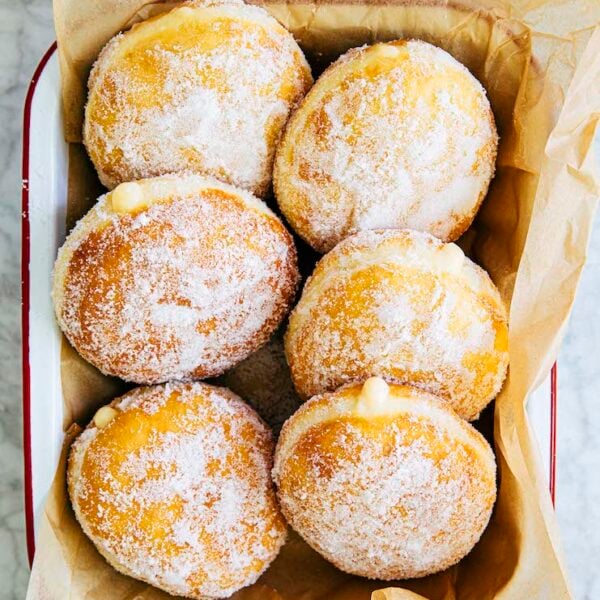
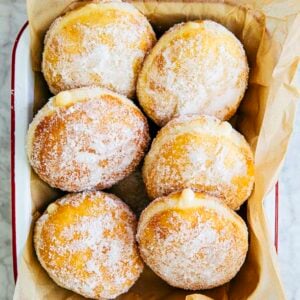

Big thoughts always need donuts. I find it weird how we can have two such different selves – 'work me' and 'life me' – and it can be so difficult to reconcile those into the same person.
These donuts look delicious. When I am too stressed I usually clean my flat to calm down.
But definitely have to try this receipt, the next time when I am too stressed. Then I can bake and clean me down. 😉
Greetings
Evelyn
!!!!!! Michelle, I can't express how much I love that you made these! Leonard's is one of our favorite things to eat whenever we visit my boyfriend's family in Honolulu. Our favorite was one month where they had guava filling as the monthly special… oh man. Yours look incredible! I love that we could (well, theoretically, maybe) have them over here too. Thanks so much for sharing this 🙂 and sorry to hear about your stress — it's funny, I find myself acting in strange ways in work v. personal life too and it frustrates me as well. Baking is a wonderful way to keep things constant (especially if you can seek solace in these little pillows of fried joy!)
That's one of my favorite Julie quotes–it really IS such a comfort to know that things will happen when you bake. Some days I come home after a long day of reading and working, and I think about how the construction workers building the apartments across the street have accomplished so many tangible results in a month while I have….deep thoughts? Yikes. I think I'm going to step into the kitchen now…
I soo need to make donuts soonish. These look delicious!
I wanna dive right into that bowl of donuts – yum!!
Michelle, I noticed that I often take different roles in different situations. I usually don't like to be in charge, but if I'm in a group that nobody is suited for it, I will do it. One psychologist said to me it's totally ok, we are not always the same, as you notice you at work and you in the kitchen it's not the same. I hope to make some kind of doughnuts next week, I hope it will work miracles for my soul as well.
This is amazing! I only just found out about malasadas today when researching Hawaii and then i stumble upon your blog and see this recipe! I just have to make these!!
Hi! I recently bought Valrhona passion fruit “chocolate” and have been trying to find recipes to use it in. Do you think it would work here melted into a pastry cream base?
I’m very excited to try making these donuts! I just tried them when I was there in March and they were great! 😊
Thanks!
Oooh, I love their passion fruit chocolate! I actually developed a Japanese cheesecake recipe for them using it! Ok, technically it’s for the yuzu choc, but you can swap in the passion fruit no problem: https://www.valrhona-chocolate.com/recipes-cakes-tart/souffle-cheesecake
Re: the pastry cream. I love that idea, but I wouldn’t know where to start with this particular pastry cream recipe. You’d need to do a lot of tinkering because it uses passion fruit puree instead of chocolate. Instead, I suggest finding a white chocolate pastry cream recipe online and swapping out the white chocolate in that recipe for the Valrhona passion fruit choc. Hope that helps!
Hi there, I was curious if you can make this recipe in an air fryer? Sorry if its a silly question, I’ve never made any kind fo donut before!
Yes but it won’t be as good 🙁
I made these today and they came out soft, pillowy and delicious. I didn’t have passion fruit so I just used basic vanilla pastry cream. Thank you for the recipe.
I made these and they were AMAZING!! I’ll definitely use this recipe over and over again!
MY Malasada Dough and Passion Fruit Pastry Cream did not thicken. Can I fix it, if it has been cooled over night
Oh no! I’m confused by what you mean about the malasada dough not thickening though. Do you mean that it didn’t rise?
If I needed to triple or quadruple this, how would that affect the amount of ingredients, mainly the yeast?
In bread, everything scales up linearly with the amount of flour. So you can just multiply all the ingredient quantities by 3 or 4 and be set!
Traditional malasadas are scooped and fried in Hawaii. This recipe for malasadas are donuts called malasadas. The Portuguese Malasada is actually shaped like an elephants ear(check out Portuguese malassadas). Hawaii started filling malasadas in the 70s with Haupia still scooped them then fried them.
Things change, just because a recipe says it is what you are looking for you should look for the authentic.
The doughnut tastes good, but I am not sure I agree with the filling direction. Going against what I know that the filling should cook a min or so after it boiled, I followed direction and remove filling after it boiled. I believed that is why it turns out a little liquidly?
Hello and thank you!!!
Can I proof in fridge, then roll and cut, then put back in fridge for a day or two before letting rise the second time ?
Yes! That works.
Thanks again!